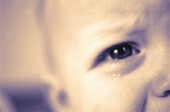
MONDAY, Nov. 17, 2014 (HealthDay News) — Half of children who experience a severe abusive head trauma before the age of 5 will die before they turn 21, according to a new study.
In addition, among those who survive severe injuries, quality of life will be cut in half, the study found.
Abusive head trauma includes shaken baby syndrome, in which an infant or toddler is shaken and suffers head injuries, according to background information in the study.
In the United States, “at least 4,500 children a year suffer preventable abusive head trauma,” said lead researcher Ted Miller, of the Pacific Institute for Research and Evaluation, in Calverton, Md.
Among children with any abusive head trauma, including minor cases, one in three “will not survive to adulthood, and even the survivors will lose significant quality of life,” Miller said.
The findings were published online Nov. 17 in the journal Pediatrics.
Miller and his colleagues noted that more than 300 U.S. children died within 30 days of an abusive head trauma in 2009. These numbers came from vital statistics data from a national inpatient database, according to the study.
For the new study, the researchers surveyed parents, caregivers or pediatricians of 170 youngsters who survived an abusive head trauma to determine the victims’ quality of life. The head traumas all occurred before the children were 5 years old. But, most — about eight in 10 — experienced the head trauma before they were 1 year old, the study found.
Miller said he was surprised by the impact of even the minor cases, which included only 16 percent of the cases overall. Another 13.5 percent involved moderate injuries, but the majority (71 percent) were severe, the study authors reported.
Almost one-quarter of children required a feeding tube, and 57 percent were blind or legally blind. Among the severe cases, 86 percent of the children lost their sight or needed corrective eye surgery, the report indicated.
“This article is a devastating reminder of how serious shaken baby syndrome is and how fragile these little ones are,” said Linda Spears, vice president of policy and programs at Child Welfare League of America. She said children under 5 are much more likely to die due to abuse and neglect for several reasons.
“One is fragility of their little bodies, and another is that they have less ability to protect themselves,” she said. “They’re also less visible in the community because they rely on the people who abuse them. They’re not in school yet and not seen in the community as much as older children.”
The researchers calculated that almost 70,000 years of combined life and disability-free life were lost due to abusive head trauma injuries to children in 2009. Youngsters who had a mild or moderate injury lost about 5 years of disability-free life. Those with severe injuries lost an astonishing 24 years of disability-free life, the investigators found.
Miller said the highest-risk period for shaken baby syndrome is the “period of PURPLE crying,” a term coined by study co-author Dr. Ronald Barr. PURPLE stands for each of the characteristics of the crying: peaking in their second month, unexpected, resists soothing, pain-like face, long-lasting and occurring in the evening.
“That’s a developmental stage that typically starts two to three weeks after birth and lasts for three or four months,” Miller said. “The crying does not signal a dirty diaper, hunger or illness, and parents understandably get frustrated by the crying and their inability to meet the baby’s needs. They do not realize that the baby simply needs to cry,” he added.
Spears said, “Shaken baby is one of the more devastating things that happen when people don’t have what they need in terms of knowledge, skills, emotional maturity, concrete services and emotional support.”
She explained that “people feel incredibly inadequate in those moments, and if you have little support and little mentoring, frustration levels can get pretty high pretty quickly because parents feel upset and angry and need to feel like they can manage the situation.”
Frustration during potty training can also lead to abuse, according to the study authors.
“[Parents] need to know that it is not a sign that they have failed their baby, and that they need to just wait it out,” Miller said. “Gently rocking a baby on your lap is fine, but never shake the baby.”
If someone suspects a child has suffered abuse or a baby has been shaken this way, Miller said they should report it to law enforcement or child protective services. Parents of children who may have been shaken, he said, should take their children to the emergency room, where immediate treatment may improve their long-term outcomes.
In a second study in the same issue of Pediatrics, researchers tested the accuracy of a new screening method to identify which children’s injuries were most likely caused by abuse.
By assessing four specific types of injuries to almost 300 children under 3 years old, the researchers determined that the method was approximately 96 percent accurate at identifying cases that were definitely caused by abusive head trauma.
Spears said providing education and support to parents, especially younger parents, is effective at preventing abusive head trauma and other forms of abuse, but it is a matter of identifying those families and getting them the support they need.
Some states, such as Wisconsin, require public schools to teach students about shaken baby syndrome, said Susan Kainz, president of Shaken Baby Association, Inc., in Madison, Wisc.
More information
Learn more about shaken baby syndrome from the U.S. National Institute on Neurological Disorders and Stroke.
Copyright © 2025 HealthDay. All rights reserved.

